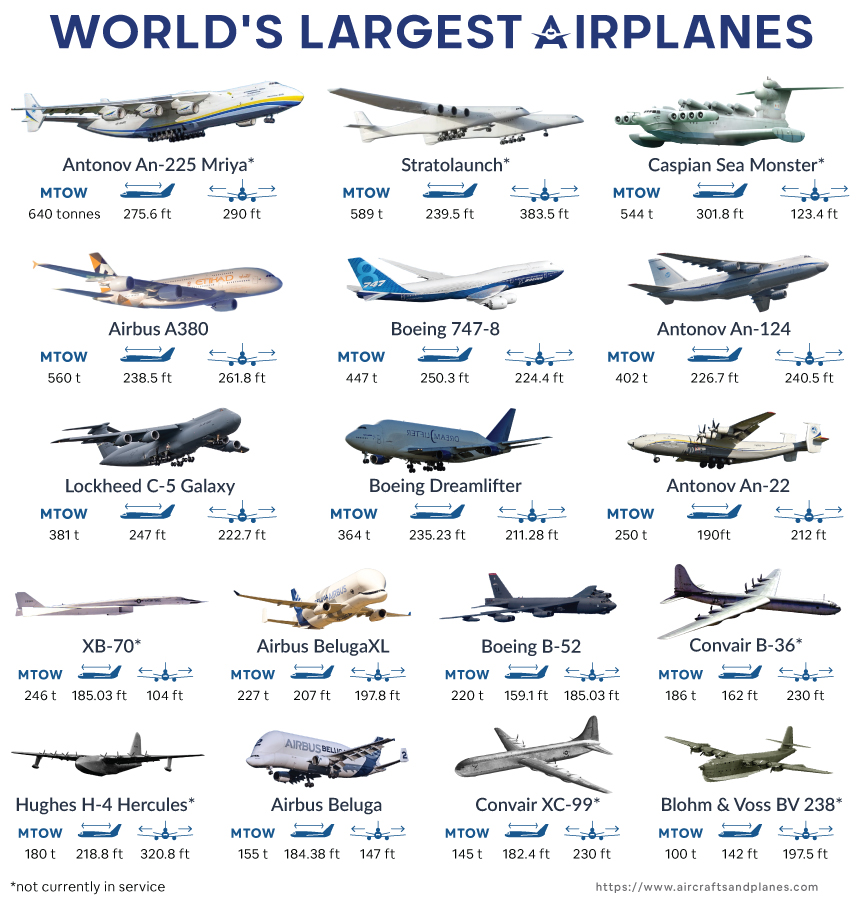Aviation has evolved remarkably, from planes barely staying aloft for moments to safely ferrying hundreds across continents. One significant aspect of this evolution is the increasing size of planes, exemplified by the Airbus A380, the largest passenger aircraft in service. There has been a trend to make airplanes more versatile and fuel-efficient, meaning the tendency to construct larger aircraft is much less. However, it is worth acknowledging the diverse array of massive planes that have soared through history alongside it.

List of Large Planes Still in Service
Some of the world’s largest aircraft are still in service. We have arranged these planes by their maximum takeoff weight (MTOW), which is the most common factor determining how much a plane can carry, including fuel, passengers, cargo, etc., and is widely used as a standardized measure.
| Aircraft | When Did it First Fly | How Many Were Built | Primary Role | Length | Wingspan | MTOW | Known For |
|---|---|---|---|---|---|---|---|
| Airbus A380 | 27 Apr, 2005 | 254 | Commercial Airliner | 238.5 ft | 261.8 ft | 560 tonnes | Highest passenger capacity airliner |
| Boeing 747-8 | 8 Feb, 2010 | 155 | Commercial Airliner | 250.3 ft | 224.4 ft | 447 tonnes | Last member of the Boeing 747 series |
| Antonov An-124 | 26 Dec, 1982 | 55 | Transport | 226.7 ft | 240.5 ft | 402 tonnes | Most capable transport until the An-225 |
| Lockheed C-5 Galaxy | 30 Jun, 1968 | 131 | Military transport | 247 ft | 222.7 ft | 381 tonnes | Largest payload capacity until the An-124 |
| Boeing Dreamlifter | 9 Sep, 2006 | 4 | Outsize cargo | 235.23 ft | 211.28 ft | 364 tonnes | Boeing 747-400 derivative, largest volume until the BelugaXL |
| Antonov An-22 | 27 Feb, 1965 | 68 | Transport | 190 ft | 212 ft | 250 tonnes | Heaviest turboprop aircraft |
| Airbus BelugaXL | 19 Jul, 2018 | 5 | Outsize cargo | 207 ft | 197.8 ft | 227 tonnes | Airbus A330 derivative, with the largest volume |
| Boeing B-52 | 15 Apr, 1952 | 744 | Bomber | 159.1 ft | 185.03 ft | 220 tonnes | Heaviest until the XB-70 |
| Airbus Beluga | 13 Sep, 1994 | 5 | Outsize cargo | 184.38 ft | 147 ft | 155 tonnes | Airbus A300 derivative, largest volume until the Dreamlifter |
List of Large Fixed-wing Aircrafts No Longer in Service
A lot of these aircraft are no longer in service. Reasons could include a preference for sleeker and more versatile models, being destroyed during a crash, or an experimental prototype that wasn’t feasible for mass production. They are similarly arranged by their maximum takeoff weight (MTOW), with a cut-off of 100 tonnes.
| Aircraft | When Did it First Fly | How Many Were Built | Primary Role | Length | Wingspan | MTOW | Why Is It Not in Use |
|---|---|---|---|---|---|---|---|
| Antonov An-225 Mriya | 21 Dec, 1988 | 1 | Transport | 275.6 ft | 290 ft | 640 tonnes | Destroyed in 2022 during Russia’s assault on Ukraine |
| Stratolaunch | 13 Apr, 2019 | 1 | Air Launch | 239.5 ft | 383.5 ft | 589 tonnes | Ownership changes leading to the craft being used for flight tests currently |
| Caspian Sea Monster | 16 Oct, 1966 | 1 | Ground Effect Vehicle | 301.8 ft | 123.4 ft | 544 tonnes | Crashed into the Caspian Sea in 1980 |
| XB-70 | 21 Sep, 1964 | 2 | Bomber | 185.03 ft | 104 ft | 246 tonnes | Retired in favor of the An-22 |
| Convair B-36 | 8 Aug, 1946 | 384 | Bomber | 162 ft | 230 ft | 186 tonnes | Retired in favor of the An-22 |
| Hughes H-4 Hercules | 2 Nov, 1947 | 1 | Flying Boat | 218.8 ft | 320.8 ft | 180 tonnes | Experimental wooden craft that made a single flight |
| Convair XC-99 | 23 Nov, 1947 | 1 | Transport | 182.4 ft | 230 ft | 145 tonnes | Retired in favor of the An-22 |
| Blohm & Voss BV 238 | Apr 1944 | 1 | Flying Boat | 142 ft | 197.5 ft | 100 tonnes | Destroyed in 1945, near the end of World War II |
Over time, there have been marked improvements in materials used to construct airplanes, as well as in aerodynamics and propulsion. These improvements have expanded the capabilities of large aircraft, influencing global travel and cargo transport and leaving a mark on how we travel throughout the skies.